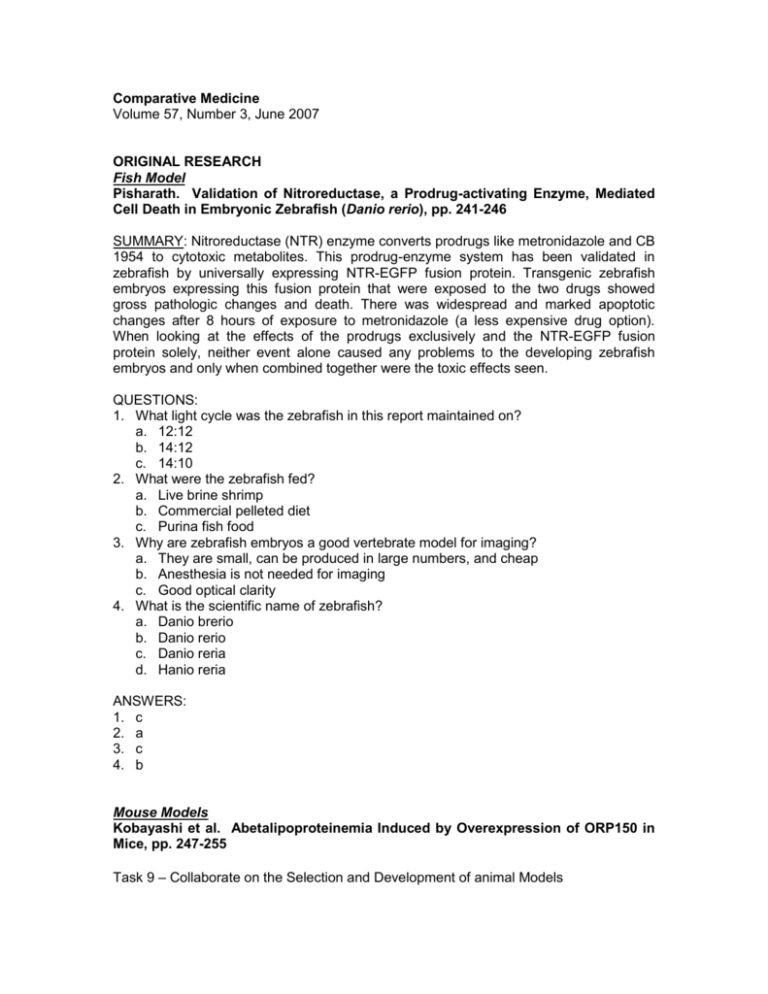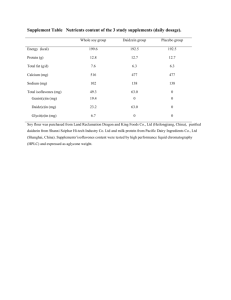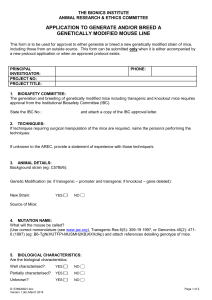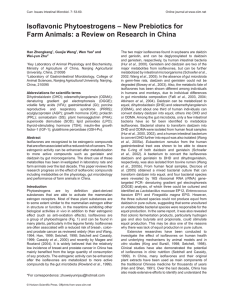Comparative Medicine - Laboratory Animal Boards Study Group
advertisement

Comparative Medicine Volume 57, Number 3, June 2007 ORIGINAL RESEARCH Fish Model Pisharath. Validation of Nitroreductase, a Prodrug-activating Enzyme, Mediated Cell Death in Embryonic Zebrafish (Danio rerio), pp. 241-246 SUMMARY: Nitroreductase (NTR) enzyme converts prodrugs like metronidazole and CB 1954 to cytotoxic metabolites. This prodrug-enzyme system has been validated in zebrafish by universally expressing NTR-EGFP fusion protein. Transgenic zebrafish embryos expressing this fusion protein that were exposed to the two drugs showed gross pathologic changes and death. There was widespread and marked apoptotic changes after 8 hours of exposure to metronidazole (a less expensive drug option). When looking at the effects of the prodrugs exclusively and the NTR-EGFP fusion protein solely, neither event alone caused any problems to the developing zebrafish embryos and only when combined together were the toxic effects seen. QUESTIONS: 1. What light cycle was the zebrafish in this report maintained on? a. 12:12 b. 14:12 c. 14:10 2. What were the zebrafish fed? a. Live brine shrimp b. Commercial pelleted diet c. Purina fish food 3. Why are zebrafish embryos a good vertebrate model for imaging? a. They are small, can be produced in large numbers, and cheap b. Anesthesia is not needed for imaging c. Good optical clarity 4. What is the scientific name of zebrafish? a. Danio brerio b. Danio rerio c. Danio reria d. Hanio reria ANSWERS: 1. c 2. a 3. c 4. b Mouse Models Kobayashi et al. Abetalipoproteinemia Induced by Overexpression of ORP150 in Mice, pp. 247-255 Task 9 – Collaborate on the Selection and Development of animal Models SUMMARY: ORP150 is a protein found in the endoplasmic reticulum (ER) and is hypoxic stress-induced and little is known about the effects of its systemic overexpression. The authors have produced a transgenic mouse overexpressing ORP150. These mice were previously discovered to have severe growth retardation concomitant with vacuolar degeneration in the heart. In this study, the authors wanted to investigate the cause of the growth retardation. Blood analysis showed significantly lower concentrations of serum triglyceride, cholesterol, glucose, and insulin. The triglyceride components that were reduced corresponded to chylomicrons and very lowdensity lipoproteins (VLDL). A lipid-loading test of the mice revealed reduced triglyceride uptake, which was mainly due to suppressed uptake of VLDLs. An intraperitoneal glucose tolerance test indicated that the mice have a significantly higher rate of glucose degradation. These findings suggest that overexpression of ORP150 in mice leads to abetalipoproteinemia with alteration of glucose and lipid metabolism. These data cold provide clues for a therapeutic target of dyslipidemia or diabetes. Background information: Cellular responses to hypoxia include various complex processes that involve altered expression of several genes, including stress-related genes that are necessary to maintain homeostasis. One such gene encodes for the 70kDa heat shock protein which is needed to protect the cell from hypoxic insult. The 150kDa oxygen-regulated protein (ORP150) has partial homology with the 70-kDa heat shock protein. Extreme hypoxia or ischemia in the brain enhances expression of ORP150. ORP150 is also a member of the glucose-regulated proteins Apolipoprotein B (ApoB) is a VLDL involved with protein folding in various hepatic cell lines. Many of these chaperone molecules bind to ApoB. In the present study, serum levels of VLDL were lower in the transgenic mice than their wild type littermates, whether fed or fasted. Because ApoB is a key component of VLDL, it seems likely that the change in VLDL levels represents a change in ApoB levels. These results suggest that ORP150 suppresses ApoB secretion as VLDL from the liver and triglyceride transport with ApoB48 as chylomicrons from the intestine lumen to the systemic circulation. In mice, as in humans, reduction of ApoB secretion is responsible for abetalipoproteinemia. ORP150 is located in the ER, and ER chaperones adhere to newly synthesized proteins prior to their folding in a mature form. Abetalipoproteinemia in the ORP150 transgenic mice is likely the result of altered ApoB secretion in association with microsomal triglyceride transfer protein (MTP) in the liver and intestine. QUESTIONS: 1. ORP150 is a protein found in the ER and is hypoxic stress-induced. T/F 2. Blood analysis showed significantly lower concentrations of serum triglyceride, cholesterol, glucose, and insulin. T/F 3. The low triglyceride levels corresponded to chylomicrons and VLDLs. T/F 4. Because ApoB is a key component of VLDL, it seems likely that the change in VLDL levels represents a change in ApoB levels. T/F 5. Abetalipoproteinemia in the ORP150 transgenic mice is likely the result of altered ApoB secretion. T/F ANSWERS: 1. T 2. 3. 4. 5. T T T T Maier et al. Proteinuria of Nonautoimmune Origin in Wild-type FVB/NJ Mice, pp. 255-266 ACLAM Task Designation: Task 1, Task 9 ACLAM Species Designation: Primary Species – Mouse SUMMARY: FVB/NJ mice are used largely as transgenic hosts; however, the suitability of this genetic background for transgenic and congenic models of systemic autoimmunity have not been reported. The study sought to characterize general phenotypic features of the FVB/NJ mouse that might be of interest when generating an autoimmune transgenic mouse model. This group evaluated FVB/NJ mice for the presence of serum autoantibodies and autoimmune kidney pathology. Previously there had been reports of albuminuria in aged FVB/NJ mice and all diagnostics performed revealed that the albuminuria was not of autoimmune etiology. Several characteristics of the FVB/NJ strain, including albuminuria, cholesterolemia, mild podocyte foot process effacement in aged female FVB/NJ kidneys and predisposition to enhanced Th2 immune responses, is reminiscent of human minimal change nephrotic syndrome (MCNS). QUESTIONS: 1. What is the hallmark of MCNS? 2. What is the effect of a decrease in plasma oncotic pressure? 3. What are the similarities in the FVB/NJ mouse strain and MCNS? ANSWERS: 1. Specific increase in urine albumin excretion leading to a decrease in plasma oncotic pressure 2. Increases the ultrafiltration of plasma through the glomeruli, potentially causing selective damage to the slit diaphragms of the foot processes in the glomerular capillaries 3. Increased levels of serum cholesterol, no autoimmune antibody development, and no immunoglobulin or C3 disposition in renal glomeruli Stettner et al. Chemotherapeutic Treatment of Xenograft Spirocerca lupiassociated Sarcoma in a Murine Model, pp. 267-271 Task 1 - Prevent, diagnose, control, and treat disease Task 9 - Collaborate on the selection and development of animal models Task 10 - Design and conduct research ACLAM Species: Primary- mouse (Mus musculus) SUMMARY: Treatment of Spirocerca lupi-associated esophageal sarcomas in dogs has been difficult. Surgical excision is often paired with chemotherapy. In this study, the authors investigated the use of pegylated liposomal doxorubicin as compared to more traditional chemotherapy since the pegylated liposomal doxorubicin has fewer and milder side effects. A mouse model was used instead of studying the disease in the dog for many reasons: 1. naturally occurring disease in dogs is usually diagnosed at an advanced stage of the disease; 2. creation of a dog model is "unethical as well as impractical" since disease progression takes several years; and 3. a mouse model will work well for this controlled study. Segments of a primary S. lupi-associated sarcoma were excised, prepared, and then transplanted into NOD/SCID mice into the subcutaneous tissue of the flank. Mice were treated with one of four chemotherapy agents (pegylated liposomal doxorubicin, doxorubicin, carboplatin, and cisplatin) or a saline control. Only the pegylated liposomal doxorubicin and doxorubicin groups demonstrated slower tumor growth than the control. There were no adverse effects in the pegylated liposomal doxorubicin group, whereas there were toxic effects seen in the doxorubicin treated animals. In conclusion, the authors state that use of the chemotherapy agent pegylated liposomal doxorubicin would be both well tolerated by animals and effective in treating the tumor. They recommend use of this agent in combination with surgical excision in the treatment of dogs with this disease. QUESTIONS: 1. What is the distribution of Spirocerca lupi? 2. What is a xenograft tumor model? 3. What are three criteria for euthanasia in mice used as tumor models? ANSWERS: 1. This parasite is found world-wide, usually in warm climates. 2. Xenograft: A surgical graft of tissue from one species to an unlike species (or genus or family). http://www.medterms.com/script/main/art.asp?articlekey=3627 http://www.medterms.com/script/main/art.asp?articlekey=5800 3. Tumor ulceration, tumor size (usually less than 10% of body weight or 1.5 to 2 cm in diameter), or cachexia. Ike et al. Lymphocytic Choriomeningitis Infection Undetected by Dirty-bedding Sentinel Monitoring and Revealed after Embryo Transfer of an Inbred Strain Derived from Wild Mice, pp. 272-281 Task 1- Prevent, Diagnose, Control, and Treat Disease Primary Species - Mice SUMMARY The authors argue that the routine sentinel monitoring may not identify the LCMV infection in mice, even when high number of mice are persistently infected. According to the authors, it needed close and substantial contact between mice, since the sentinel mouse exposed to the infected bedding didn't seroconvert even after exposing the dirty bedding from infected MAI/Pas mice at least 3 consecutive weeks over a period of 6 months. Moreover, the authors found the recipient dams seroconvert after embryo transfer, indicating the problems with eliminating LCMV by embryo transfer. So the progeny derived by embryo transfer must be tested by IFA and RT-PCR. QUESTIONS: 1. What does MAI/Pas strain of mouse stand for? a. Monoclonal antibody induction of Pasteur institute b. Mouse antibody induction of Pasteur institute c. Massachusetts antibody induction d. M.m.musculus, Austria, Illmitz, Pasteur 2. FIMR stands for a. Federation of International Mouse Resources b. Federation of Indian Mouse Resources c. Federation of International Mouse Research d. Fellow of International Mouse Research ANSWERS: 1. d 2. a Rat Model Rafii et al. Metabolism of Daidzein by Fecal Bacteria in Rats, pp. 282-286 Task 9 – Collaborate on the Selection and Development of Animal Models Primary Species - Rat SUMMARY: Daidzein is a weakly estrogenic soy isoflavonoid with potential health benefits for hypercholesterolemia and osteoporosis. Human intestinal microflora converts daidzein either to equol, which is highly estrogenic, O-desmethlyangolensin (ODMA), which is nonestrogenic, or to dihydrodaidzein. The pharmacologic effects of phytoestrogens are often extrapolated from animal models to try and predict human responses. In this study, the role of rat intestinal microflora in the metabolism of daidzein was studied. Fecal pellets were obtained from untreated big blue transgenic rats (derived from Fisher 344 - Taconic) and also from rats that were given 250 ppm, 1000 ppm daidzein or no daidzein, then treated with dimethylbenz(a)anthracene. In vivo and in vitro studies were performed on the feces to detect metabolites produced by daidzein. The fecal bacteria from all of the rat pellets converted daidzein to dihydrodaidzein, which was rapidly converted to aliphatic compounds. The disappearance of daidzein was shown to be the result of microbial activity of rat fecal microflora. Microbial consortia were necessary for this conversion, as individual or combinations of these bacteria did not metabolize daidzein. Also, brain-heart infusion (BHI), which supports the growth of both strict and facultative anaerobes, allowed growth of bacteria capable of metabolizing daidzein under anaerobic conditions. Neither O-DMA nor equol were found in the rat fecal metabolites of daidzein. Rat fecal microflora quickly metabolized daidzein to dihydrodaidzein, and further to metabolites that could not be detected. Unlike humans and monkeys, where daidzein is detectable even after 15 d, daidzein disappeared rapidly when incubated with rat feces, indicating that these bacteria metabolize it to compounds that can not be detected by HPLC. The differences in metabolism of isoflavonoids by colonic bacteria of experimental animals should be considered when results from experimental animals are extrapolated to humans. QUESTIONS: 1. What strain of rat is the transgenic big blue rat derived from? 2. T/F Metabolism of daidzein by fecal bacteria in rats was found to be similar to that of primates. 3. What type of compound is daidzein? ANSWERS: 1. Fisher 344 - Taconic 2. F. Unlike in humans, neither O-DMA nor equol were found in the rat fecal metabolites of daidzein. Also, daidzein disappeared rapidly when incubated with rat feces, compared with primates, in which daidzein is detectable even after 15 days. 3. Daidzein is a weakly estrogenic soy flavonoid with potential health benefits for hypercholesterolemia and osteoporosis Canine Model Yunusov et al. Intussusception in Canine Recipients of Hematopoietic Cell Grafts and Surgical Correction, pp. 287-291 Task 9 - Collaborate on the Selection and Development of Animal Models Primary species – dog SUMMARY: Intussusception is a common complication on dogs receiving hematopoietic cell grafts (HCT) or organ transplantation. In the present study the incidence of intussusception after HCT was 4.9%. Dose of irradiation, source of HCT, immunosuppressants, sex, and age at transplantation were not significantly associated to intussusception. Of the sixteen dogs developing intussusception, 9 were managed surgically and 7 non-surgically. Six of 9 dogs were successfully managed by surgery, and none of 7 was successfully managed in the non-surgery group. QUESTIONS – True/False: 1. Intussusception in a common complication in dogs receiving hematopoietic transplants. 2. Dose of irradiation, source of HCT, immunosuppressants, sex, and age at transplantation were not significantly associated to intussusception. 3. Intussusception, in dogs receiving hematopoietic transplants, can be successfully managed by surgery. ANSWERS: 1. True 2. True 3. True Swine Model Klemcke et al. A Novel Swine Model for Evaluation of Potential Intravascular Hemostatic Agents, pp. 292-297 ACLAM Task Designation: Task 9 ACLAM Species Designation: Primary Species – Pig SUMMARY: Hemorrhage is the leading cause of death due to wounds received during wartime combat or resulting from civilian trauma. Drugs to augment the clotting mechanisms would be useful to preventing excessive blood loss. An animal model to determine the efficacy of potential hemostatic agents was developed. Paired mesenteric arteries and veins were isolated and blood flow enhanced using a U-shaped tube containing sterile saline at 39oC. Bleeding time (BT) and activated clotting time (ACT) were measured from severed mesenteric blood vessels before or after injection of heparin and with or without protamine sulfate. Heparin increased BT and ACT in dosedependent manners which were decreased after multiple administrations of protamine. Liver injuries were also produced in these pigs and various blood loss parameters evaluated. Overall, studies evaluating BT and in vitro hemostatic parameters and exsanguinating liver injury featuring parenchymal and small-vessel bleeding were performed using the same animal. QUESTIONS: 1. What is the primary blood supply to the small intestines in pigs? a. Posterior mesenteric artery b. Cranial mesenteric artery c. Common mesenteric artery d. Medial mesenteric artery 2. What is the survival time in minutes resulting from exsanguinating liver injury in pigs? a. 150 mins b. 200 mins c. 80 mins d. 50 mins 3. What problem makes it difficult to use the ears of pigs to evaluate Bleeding time? a. Influence of ear location on BT b. Fighting among housed pigs c. Inability to maintain constant ear temperature d. All the above ANSWERS: 1. b 2. c 3. d Swine and Nonhuman Primate Model Parra et al. Retrospective Analyses of Serum Lipids and Lipoproteins and Severity of Disease in 60Co-irradiated Sus scrofa domestica and Macaca mulatta, pp. 298-304 Primary Species (Sus scrofa and Macaca) SUMMARY: Neutropenia and low serum cholesterol levels are associated with increased mortality and severity of disease in humans. The lipoproteins, carrier molecules of cholesterol in blood are categorized as very-low density lipoprotein (VLDL), intermediate, low-density (LDL), and high-density (HDL) lipoproteins. HDL cholesterol is cardio-protective and so considered as good cholesterol. LDL is the carrier of oxidized cholesterol from liver to cell, and is directly related to increased cardiovascular risk (bad cholesterol). This retrospective study was conducted to prognosticate the value of total lipids and lipoprotein concentrations in irradiation-induced (60Co) acquired infections in Yucatan Pigs and Rhesus monkeys grouped in two categories: septic and non-septic. The radiation doses were designed to induce severe hematological and immunologic depression in both pigs (3.5Gy at the rate of 0.6Gy/min) and rhesus (6.5 Gy at the rate of 0.4Gy/min). Both, Pigs and Rhesus showed lowered serum HDL concentrations after sepsis. Though, septic pigs had marked decrease in cholesterol concentrations compared with non-septic groups, both groups had concentrations within normal range for the species. But, a 34% decrease within a 24hr period seems to be associated with severity of clinical signs in pigs. In NHP’s cholesterol less than 100mg/dl suggested sepsis. An HDL concentration less than 45mg/dl proved to be more predictive measurement of sepsis and clinical outcome of NHP. On the basis of pre-irradiation baseline sample in NHP, decrease in lipid and lipoprotein concentrations more likely reflected a response to inflammation rather than their susceptibility to infection resulting from low lipid and lipoprotein concentrations The beneficial effects of lipoproteins in sepsis related to their capability to neutralize the LPS and lipoteichoic acid, with HDL has the highest binding capacity. Thus data suggests that low serum lipids especially low HDL, are reliable markers for prognosis of disease in febrile neutropenic patients after high doses of gamma-radiation. QUESTIONS: 1. Which of the following cholesterol is directly related with increased cardiovascular risk a. Increased HDL b. Decreased HDL c. Increased LDL d. Decreased LDL e. Increased intermediate cholesterol 2. Low levels of ___________ and ________ are considered as reliable markers for to prognosticate the disease in febrile neutropenic patients after high doses of gammairradiation. 3. The beneficial effects of lipoproteins in sepsis is attributed to a. Their ability to induce inflammatory cytokines b. Ability to induce endotoxin release c. Capability to neutralize more than 90% of lipopolysaccharide d. All of the above ANSWERS: 1. c 2. Cholesterol and HDL 3. c Nonhuman Primate Model Kimura. Dermal Melanocytosis in Japanese Monkeys (Macaca fuscata), pp. 305310 Task 9- Collaborate on the Selection and Development of Animal Models Primary Species- Monkey SUMMARY: The skin of Japanese monkeys shows diffuse discoloration resembling human melanocytosis. Very few laboratory animals have melanocytes in the dermis. The purpose of the study was to characterize the gross appearance, skin color and histopathologic findings of the skin. Tissue specimens from both pigmented and non pigmented sites were examined histopathologically. A colorimeter was used to detect differences in skin color due to dermal melanocytosis and quantify the pigment concentration numerically. Pigmented sites lacked melanocytes in the epidermis, but the dermis had numerous melanocytes with abundant melanin. Nonpigmented sites lacked melanin granules in both the epidermis and dermis. Histopathologically the epidermis in Japanese monkeys differed from that in humans. The simian epidermis contained no DOPA-positive melanocytes with melanin granules. These results are similar to those described for Macaca mulatta. The dermal melanocytes suggested that the pigmented condition in Japanese monkeys was similar to dermal melanocytosis in humans. Japanese monkeys are a useful animal model to investigate the etiology and effective therapy of human dermal melanocytosis. Note: Mexican hairless dogs are a good experimental model of epidermal pigmentation conditions such as suntan reactions and senile lentigines. QUESTION: 1. In Japanese monkeys pigmented skin contained melanocytes in? a. The dermis b. The epidermis c. The subcutaneous tissue d. The neural tissue ANSWER: 1. a








